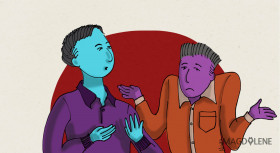It was in late April when I found that my life had turned upside down. That Monday morning, my casual buddy was trying to examine my lady part when he found some lesions on my vagina. I first thought it was just some ingrown hair issues, but once I saw the picture he took for me, I felt as if a giant brick just hit my face.
Shortly after, I went to a clinic where I usually get my HIV test done. It was a tiring process, from pap smear to vaginal discharge test, and in the next two days I took HPV and Herpes tests. I had to wait for about two weeks for the results, and during that time I was a nervous wreck, barely able to sleep and eat. In two weeks alone I lost a few kilograms.
When the result arrived on my inbox, I slowly took a peek at it. The diagnose, HPV low risk, stunned and frightened me. I didn’t know what HPV was or what steps I needed to take. I was obviously angry with the carrier who infected me with it, but I knew that no amount of anger would ever take the genital warts away. In my office chair, I pondered the solution.
I was given the option of having the warts cauterized, which was a relief. Because of my crazy workload at the time, I tried to distract my mind off the disease, but the warts kept spreading. It took a month of treatment to get rid of the warts. The whole process involved chemical cauterization, starting from applying a thin layer (depending on the size of the warts) of 80 percent of Trichloroacetic acid (TCA) until I was fully healed. It was really awful because my warts had spread to almost the whole outer labia all the way toward my anus. As disgusting as this sounds, I hadn’t notice or felt the severity of my condition, until the physician checked them for me.
The treatment cost a lot, but it was nothing compared to the risk of having it and carrying it for the rest of my life. But at the same, I worried about the social stigma attached to the condition if my family or my future partner ever found out.
The moral of the story is always inform your sex partner if you have a sexually transmitted disease (STD), because wearing a condom doesn’t help the spreading at all. And, no, you don’t have to have sex with multiple partners to contract STD, all it takes is an intercourse with one person who has it. So once you are sexually active, you must check yourself for a complete STD test.
And if you have contracted it, be honest, own it and educate yourself about STD to get the proper treatment for it.
Olivia Michelle is an introvert who works for a research company in Indonesia. Observing is one of her hobbies since it relates strongly to her work on a daily basis.







Comments